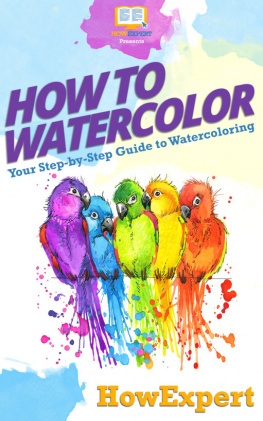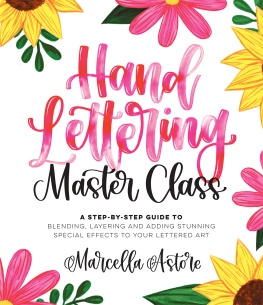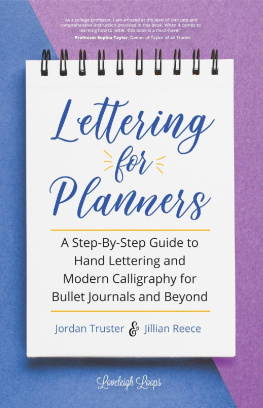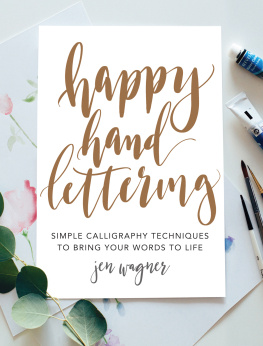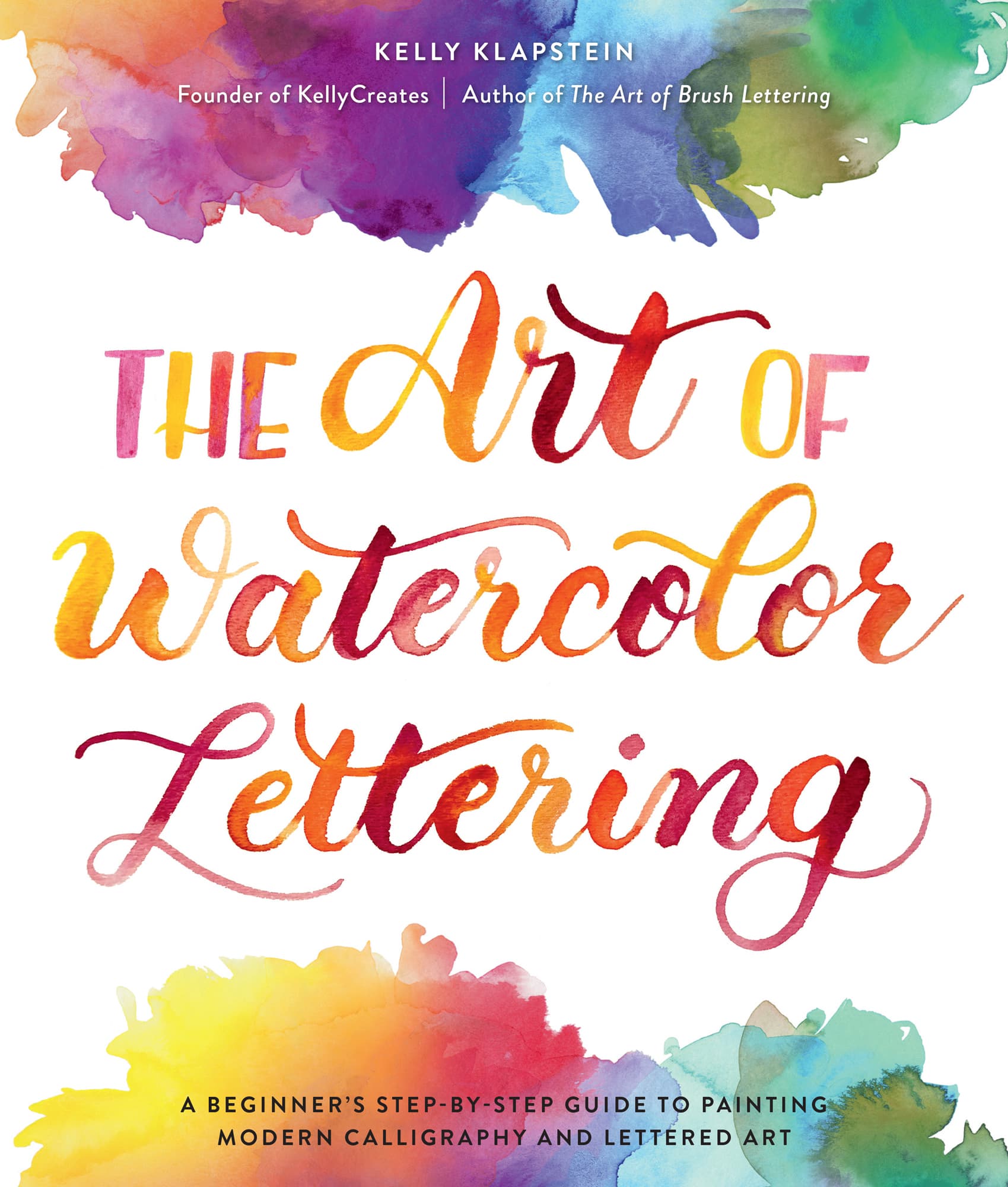Contents
Guide
A BEGINNERS STEP-BY-STEP GUIDE TO PAINTING
MODERN CALLIGRAPHY AND LETTERED ART
KELLY KLAPSTEIN

Introduction
I can clearly remember art time in elementary school when the teacher would bring out the paints. Finger painting and those thick globs of color seemed too messy and indiscriminate to me. But when the tempera paint cakes and water cups and brushes landed on my desk, I felt my heart beat a little faster. The simple act of swiping paint colors onto paper was a satisfying and creative experience that brought me great joy. I didnt think of myself as a skillful painter, but I loved the feeling of being artistic with a brush in hand.
At the age of ten, I went through a paint-by-numbers phase and became obsessed with filling in the colors bit by bit until a picture formed. My mother always encouraged crafty projects and bought me lots of paint-by-numbers sets, but suddenly one day I just stopped. The paint-by-numbers project I was working on was only half finished, but I refused to continue. I think this was because I had reached the point of wanting to paint something different, something original.
I was always crafty, but never thought of myself as an artistexcept with a pen and a big imagination. Writing has been my creative expression and outlet since my childhood. I would lose myself by filling reams of loose-leaf paper with fantastical stories, telling tales about creatures and people brought to life by my pen.
It astonishes me to think that not until this point in my adult life had I ever decided to try calligraphy or hand lettering, but when I did, I knew I had found my passion. Maybe its the act of writing thats ingrained in my soul. When I began using water-based brush pens for lettering, I also began using them with water on watercolor paper and painting simple sketches. The colorful brush pens brought me back to those early painting days in school, and I quickly realized how much Im drawn to the beauty of paint, especially watercolor.


While my lettering skills with my brush pen were evolving, I bought a few good watercolor brushes and some watercolor paints and started to hand letter with watercolor. At first, I mimicked the brush pen technique. But then, I became more playful and attempted other letterforms and styles. The fluidity and unpredictable characteristics of watercolor did not deter me. They intrigued me. Somehow, the paintbrush felt right in my hand, and I was entranced with the paint colors on the paper. Combining my love of writing, calligraphy, and paint brings me to a very joyful place right here in this book. And I hope it brings you all those wonderful artistic creative feelings too.
I wish you a joyful, peaceful, and beautiful experience exploring the art of watercolor lettering.
1
What Youll Need
As with any artistic venture, having the right tools can make all the difference. When it comes to learning and practicing lettering with watercolor, there are a few important considerations, which youll read about in this chapter. Through trial and error, I discovered which products work best for watercolor lettering and which ones didnt. Theres a range of supplies to purchase for every budget, so that anyone can afford to learn watercolor lettering. Choosing the right brushes, paints, and paper will help make your learning experience easier and stress-free.
WHAT IS WATERCOLOR PAINT?
Watercolor is a paint that consists of a binder (gum arabic) mixed with pigment. The pigments can be either natural or synthetic. The first watercolor paints were derived from organic sources such as plants and minerals, some of which are still used today.
What Kind of Watercolor Paint Should I Use?
Watercolor paints are available in a range of quality levels, and Ive taught with all of them. Lets be real: Can you practice with cheap childrens pan paints? I say, Yes, you can. Even I used these pans in an hour-long introductory class to watercolor lettering, but the appearance of the dried paint on the paper will be chalkier and more opaque, as compared to the lovely translucent colors we admire. However, if youre working on artistic effects, like blending colors, then I highly recommend using the artist-grade paints that are best for these techniques.
Lets take a look at the three most common options of watercolor paint used for lettering.

Pans or Cakes
Pan watercolors are made into dry, solid little cakes by compressing dried paints into individual containers. You activate the watercolor by touching the dry cake with a wet brush.
These pans seem very popular with beginner painters, especially children; however, theyre the least suitable for watercolor lettering. Why? Because you need to build up a puddle of watercolor on your palette to easily paint letters. If youre painting a long quote with a solid color, youll be exerting significant effort going back and forth from pan to palette to water cup repeatedly. Some people avoid this tiresome process by spraying, misting, or adding lots of water to cakes, resulting in tiny pools of watercolor right inside the pans. This isnt the best practice because water sitting in pans for long periods can cause the binder and pigment to separate more quickly over time.
HANDLING PAINTS SAFELY
Some watercolor paints contain toxic substances like cadmium and cobalt, so take care when handling the paints and cleaning your brushes.
Avoid using kitchen utensils, cups, and bowls as part of your watercolor tool kit unless youve designated them to use solely for painting.
Wash any tools you use with watercolors in a bathroom, laundry room, or studio sink rather than in your kitchen sink.
Tubes
Tube watercolors, which have a toothpaste-like consistency, are a concentrated form of paint. Lots of artists build up their own pans of paint with tubes and palettes, but for lettering, well use the tubes a little differently: Squeeze a tiny bit of paint from the tube into a palette well, add a little water, and then mix together. A pipette is handy for adding small amounts of water to the palette wells. A toothpick or similar item can be used for mixing the paint with water instead of a brush (to avoid wasting paint) to attain the right liquid consistency and color for painting. The more water you add, the lighter the value of the color.


